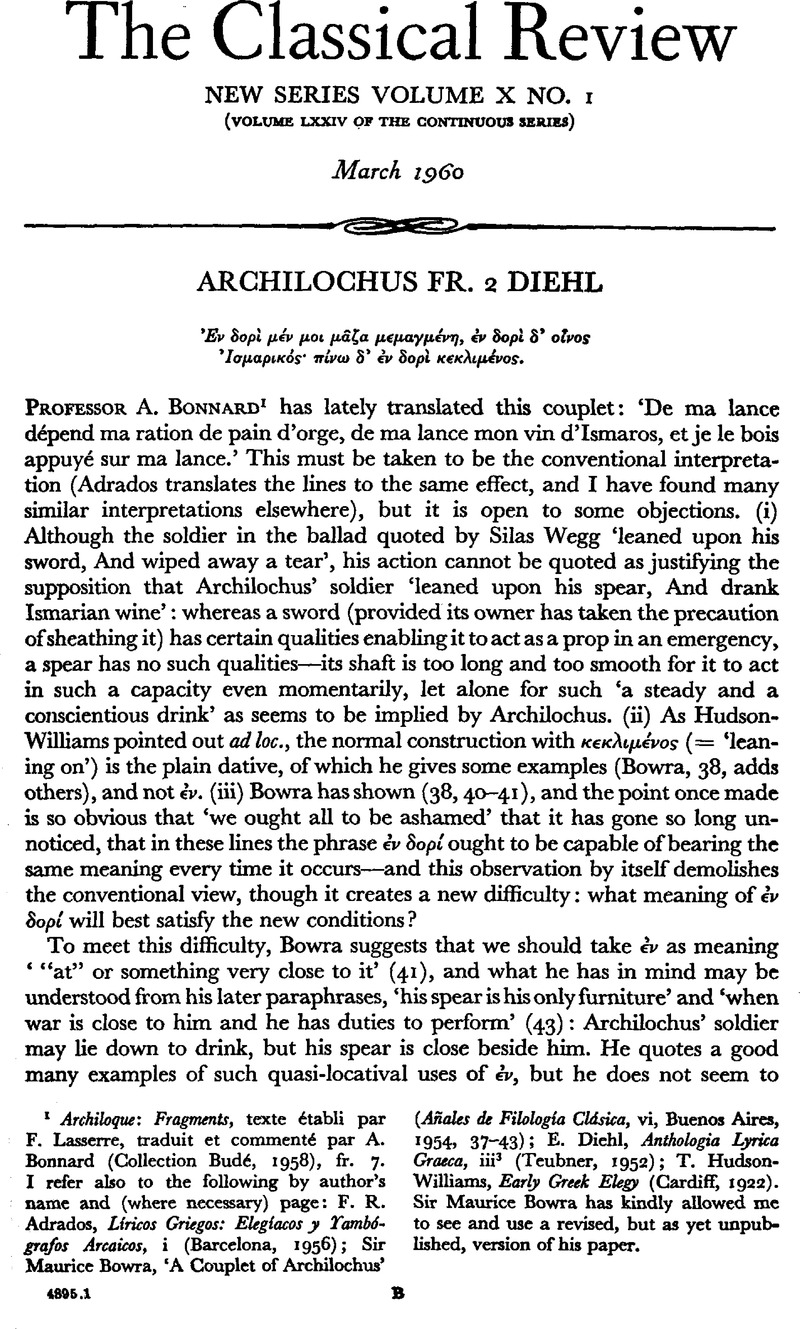Article contents
Archilochus Fr. 2 Diehl
Published online by Cambridge University Press: 13 February 2009
Abstract

Information
- Type
- Review Article
- Information
- Copyright
- Copyright © The Classical Association 1960
References
page 1 note 1 Archiloque: Fragments, texte établi par F. Lasserre, traduit et commenté par A. Bonnard (Collection Budé, 1958), fr. 7. I refer also to the following by author's name and (where necessary) page: Adrados, F. R., Líricos Griegos: Elegíacos y Yambó-grafos Arcaicos, i (Barcelona, 1956);Google ScholarBowra, Sir Maurice, ‘A Couplet of Archilochus’ (Añdes de Filología Clásica, vi, Buenos Aires, 1954, 37–43);Google ScholarDiehl, E., Anthologia Lyrica Graeca, iii 3 (Teubner, 1952);Google ScholarHudson-Williams, T., Early Greek Elegy (Cardiff, 1922).Google Scholar Sir Maurice Bowra has kindly allowed me to see and use a revised, but as yet unpublished, version of his paper.
page 2 note 1 Xen. Mem. iii. 9. 2: ![]() (so codd.; the Oxford text follows Stobaeus in omitting both occurrences of ⋯ν) may perhaps be another example; but I feel that the use of ⋯ν here may be influenced by three factors: (1) the π⋯λται, which are put ‘oné; (2) a certain locatival effect in διαγων⋯ζεσθαι; (3) the possibility of confusion with the datives Θρᾳξ⋯ν and Σκ⋯θαις.
(so codd.; the Oxford text follows Stobaeus in omitting both occurrences of ⋯ν) may perhaps be another example; but I feel that the use of ⋯ν here may be influenced by three factors: (1) the π⋯λται, which are put ‘oné; (2) a certain locatival effect in διαγων⋯ζεσθαι; (3) the possibility of confusion with the datives Θρᾳξ⋯ν and Σκ⋯θαις.
page 2 note 2 I owe this suggestion to Professor T. B. L. Webster; he once observed to me that this on line could not mean that Harmodius and Aristogeiton hid their swords in myrtle-branches, because (a) myrtle-branches would not be well adapted for the purpose, and (b) the conspirators' reason for choosing the day of the Panathenaic procession for their attempt was that it was the one occasion when they could appear in arms without exciting suspicion (Thuc. vi. 56. 2). He suggested that ⋯ν μ⋯ρτου κλαδ⋯ might mean ‘along with’ (or ‘when I carry’) ‘a myrtle-branch’, and mentioned Archilochus' ⋯ν δορ⋯ as a possible parallel.
page 3 note 1 Archilochus may then rank as a master of word-play with Thomas Hood, of whose verbal audacities this may serve as an example: ‘A cannon-ball took off his legs, So he laid down his arms; And as they bore him from the field, Said he, “Let others shoot, For here I leave my second leg, And the Forty-second Foot!”’
page 4 note 1 Another poem which may be complete is the so-called ‘Hymn to Heracles and Iolaus’ (fr. 120 Diehl), cf. Pind. Ol. 9. 1–2: ![]() .
.
- 1
- Cited by

